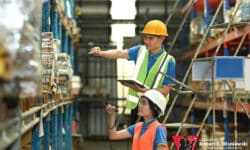Working in a confined space can make an ordinary job far more difficult. Not only is it small, as the name implies, the restricted area means that dangers can multiply quickly.
There are any number of things that can go wrong that could cause significant injury. Understanding the risks that come with working in a confined space can help you know the precautions you should take to do your job safely.
Here are a few FAQ’s on enclosed spaces that can help you understand the risks and precautions for working in an enclosed area.
What is an confined space?
OSHA defines a “confined space” as a space that:
- Is large enough for an employee to enter and perform assigned work,
- Has limited means for entry, and
- Is not designed for continuous occupancy.
These factors give enclosed spaces a unique set of risks and hazards. When you’re working in a confined space, be certain that you are taking appropriate precautions to stay safe while working.
What are some of the hazards that come with working in a confined space?
Atmosphere hazard. Atmosphere hazards are particularly dangerous in confined spaces since adequate ventilation can be difficult. This would include spaces where the you have a limited (or excessive) oxygen supply or a space where there is a concentration of noxious gases.
zEngulfment hazard. Spaces that contain any flowing substance that can completely cover a worker pose a significant risk. Engulfing substances can include liquids or fine solids, like grain, that can fill or plug the respiratory system causing asphyxiation or that could crush or strangle.
What are the safety basics for working in an enclosed space?
Take ventilation precautions. When possible, improve or supplement the ventilation. If you begin to feel dizzy or light-headed, get out immediately. Noxious gases can get to a dangerous level quickly.
Have exit and rescue plans. Know the best and fastest way to get out of a confined space if the area becomes unsafe. Before entering, make sure you will be able to get in and out of the space. Also, don’t go into a confined space without saying something to someone first. Ideally, have someone outside the space while you are working so that you have immediate help in an emergency and someone who can easily check on your health and safety.


